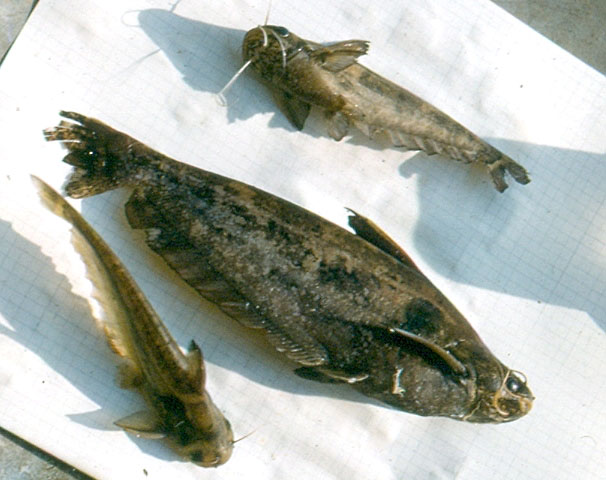| Schilbeidae (Schilbid catfishes) |
| 21.7 cm SL (male/unsexed) |
|
demersal; freshwater; pH range: 6 - 7.5; dH range: 20, |
| Africa: Chiloango basin in Angola (Cabinda enclave) and Democratic Republic of the Congo, and the middle and upper Congo River basin including Pool Malebo (= Stanley Pool) and the drainages of the Ubangi and Kasai (Ref. 43912, 78218). Probably absent from the Chad basin (Ref. 43912). |
|
Dorsal spines (total): 1-1. Diagnosis: adipose fin always absent; head rounded; lower jaw shorter than upper jaw; nasal barbel at least reaching to anterior border of opercle; inner side of pectoral spine feebly serrated; particular coloration characterized by irregularly marbled pattern; caudal and anal fin almost continuous (Ref. 43912).
Description: 43-59 branched anal fin rays; 39-43 non-fused vertebrae; 8-11 branchiostegal rays on one side of head; caudal peduncle always deeper than long; barbels rather well developed; nasal barbel reaches at least to anterior border of opercle and at maximum to just beyond posterior border of opercle; maxillary barbel reaches at least to just beyond opercle and at maximum to just before distal end of pectoral spine (when folded against body); inner mandibular barbel short and reaches at least to middle of eye and at maximum to just beyond eye; outer mandibular barbel at least reaches to posterior border of opercle and at maximum to 3/4 of length of pectoral spine; caudal fin moderately forked, both caudal fin lobes as well as pelvic fin lobes more or less rounded (Ref. 43912). A very peculiar species, somewhat resembling S. yangambianus (also a typical forest species) and S. brevianalis which also have an irregularly marbled coloration; S. marmoratus however is easily distinguished by the absence of an adipose fin (Ref. 43912).
Coloration: in life as well as in preserved specimens: dorsally dark brown; flanks irregularly marbled: dark brownish or blackish spots, alternating with paler irregular spots, present; large dark spot (tympanum spot) on each flank just behind head, where swim-bladder lies just below skin; belly and ventral side of head paler (whitish) and covered with small brown stripes and small spots; pectoral fins dark brown, outer rays darker than inner ones; dorsal fin dark coloured, often with pale rectangular region in middle; anal fin brown over its entire length; caudal fin dark at its base, followed by small pale zone, rest of tail (both fin lobes included) dark coloured (Ref. 43912). |
| Confined to lakes and rivers of moderate size; forest species which is often found in small forest waters; mainly carnivorous (Ref. 43912). Oviparous, eggs are unguarded (Ref. 205). |
|
Least Concern (LC); Date assessed: 16 February 2009 Ref. (130435)
|
| harmless |
Source and more info: www.fishbase.org. For personal, classroom, and other internal use only. Not for publication.

